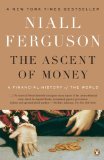I wanted to read “The Ascent of Money” by Niall Ferguson after having watched a local broadcast of the eponymous documentary-series from Channel 4. Each episode of the documentary-series was about an aspect of finance and was presented by the author himself. As they were broadcast around the time of the latest financial crisis (called the “Great Recession” by many people), it made for some very interesting viewing. Hoping to find more depth and greater detail in the book, I have to report that I was mildly disappointed after reading it. If you are totally new to the world of finance though, you will very likely find the the documentary-series (or the book) entertaining and insightful.
Apart from the Introduction and the Afterword, the chapters of the book follow the same themes as the episodes in the documentary-series and are similarly-named. They are:
- Dreams of Avarice - on the rise of credit and the banking system.
- Human Bondage - on the rise of the bond market.
- Blowing Bubbles - on the rise of the stock market.
- Risky Business - on the insurance industry.
- Safe as Houses - on the real-estate market.
- Chimerica - on the symbiotic relationship between China and America and how inextricably-linked they are these days.
So closely do most of the chapters follow the corresponding episodes that at times I felt as if I was reading the script for the series instead of a book proper. The book does not add significantly to the series and is only somewhat more detailed. It does provide lots of notes and references though that will help you research more on a topic should you so desire. This is not to say that the material is not worth your time, but merely that if you've either seen all the episodes or read the book, it will probably be a waste of time to then go for the other medium of presentation.
The material is quite entertaining and quite revealing at times, perhaps even for a seasoned professional in finance. I for one did not know of the important role played by financial factors in the French Revolution, the defeat of Napolean, the American Civil War, the First World War, etc. Popular history, and I dare suspect even academic history, just does not illuminate such important aspects of historical events. The author must be commended for carrying out the research to unearth these factors and the corresponding players.
It is quite clear from the presentation that the author does not really believe in the “rational actor” model or the “efficient markets hypothesis” that are a staple of mainstream economics. He wants us to be aware of the follies of men and economic mishaps of the past as we look into the future. This level-headed approach to finance enabled him to make predictions at the time of preparing this material that have since played out more or less as he had predicted.
I would really have liked a more structured look into the historical origins of the monetary system from its barter-based origins. The material focuses almost exclusively on the Western world, mentioning innovations in the Middle East, India and China almost in passing. This is a glaring omission that makes it somewhat lopsided. In each area of finance, the author focuses on a few entertaining or insightful events and characters, again making it a lopsided presentation. These omissions might have been justified given the constraints of a documentary-series, but not in a book.
